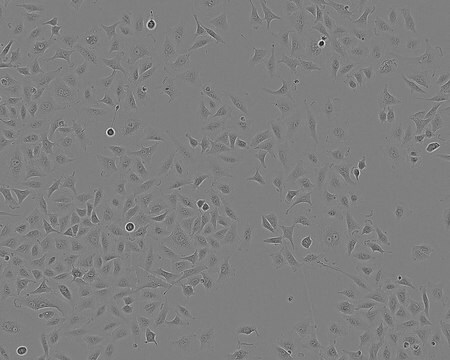3T3 L1 Cell Line from mouse
86052701, mouse embryo, Fibroblast-like
Synonim(y):
3T3L1 Cells, NIH-3T3-L1 Cells, NIH3T3-L1 Cells
Zaloguj sięWyświetlanie cen organizacyjnych i kontraktowych
About This Item
Kod UNSPSC:
41106514
Polecane produkty
product name
3T3 L1 Cell Line from mouse, 86052701
pochodzenie biologiczne
mouse embryo
opis
embryo
tryb wzrostu
Adherent
kariotyp
2n = 40; Aneuploid with unstable karyotype
morfologia
Fibroblast-like
produkty
Not specified
receptory
Not specified
metody
cell culture | mammalian: suitable
Warunki transportu
dry ice
temp. przechowywania
−196°C
Pochodzenie linii komórkowej
Mouse Embryo
Opis linii komórkowej
3T3 L1 is a continuous strain of 3T3 developed through clonal isolation. The cells are not contact inhibited. Cells can be induced to become adipose-like using the method described in the subculture routine information. Appearance of adipocytes can take weeks to achieve.
We would like to manage customer expectations with regard to the potential of the current 3T3 cell line stocks to differentiate into adipocytes. If you intend to use the cells for adipocyte differentiation please note: When cells are stimulated, using an appropriate protocol, differentiation may take several weeks to occur, e.g. 2 - 5 weeks, and the proportion of the population which differentiates can be limited. If you have previously used 3T3 cells from an alternative source we cannot guarantee the differentiation performance will be the same.
We are working to source a new stock of this cell line that has a higher rate of adipocyte differentiation potential which we aim to be able to offer in the future. When this is available we will update the cell line details on the website.
We would like to manage customer expectations with regard to the potential of the current 3T3 cell line stocks to differentiate into adipocytes. If you intend to use the cells for adipocyte differentiation please note: When cells are stimulated, using an appropriate protocol, differentiation may take several weeks to occur, e.g. 2 - 5 weeks, and the proportion of the population which differentiates can be limited. If you have previously used 3T3 cells from an alternative source we cannot guarantee the differentiation performance will be the same.
We are working to source a new stock of this cell line that has a higher rate of adipocyte differentiation potential which we aim to be able to offer in the future. When this is available we will update the cell line details on the website.
Zastosowanie
3T3 L1 cell line from mouse has been used to study changes in lipopolysaccharide-induced inflammatory cytokine production and anti-inflammatory effects of galectin-3 in 3T3-L1 adipocytes. It has also been used in neutral red uptake assay (NRU) and neutral red release assay (NRR) as in vitro methods to assess eye irritation hazards of formulations and chemicals.
pożywka hodowlana
DMEM + 2mM Glutamine + 10% Calf Serum (CS)
Rutyna subkultury
Split sub-confluent cultures (70-80%) 1:50 to 1:100 i.e. seeding at 2-4x10,000 cells/cm2 in a 75cm2 flask using 0.25% trypsin or trypsin/EDTA; 5% CO2; 37°C. Never allow the culture to become fully confluent and subculture every 3 days. To stimulate differentiation into adipocytes grow the cells to confluency using the DMEM + 10% calf serum. 2 days after confluency induce differentiation by adding 0.5 mM 3-isobutyl-1-methylxanthine (IBMX), 0.25uM Dexamethasone and 1ug/ml Insulin in DMEM with 10% Foetal Bovine Serum (FBS). After 2 days remove the IBMX and dexamethasone but maintain with insulin for another 2 days. On day 4, after inducing differentiation, and thereafter, culture the cells in DMEM with 10% FBS. Change medium every second day. Differentiation may take several weeks to occur e.g. 2 - 5 weeks. Differentiation begins in patches but with time a significant percentage of the population should change. Before any experiments on the differentiated cells incubate in serum-free DMEM for 2 hours.
Inne uwagi
Additional freight & handling charges may be applicable for Asia-Pacific shipments. Please check with your local Customer Service representative for more information.
This page may contain text that has been machine translated.
Certyfikaty analizy (CoA)
Poszukaj Certyfikaty analizy (CoA), wpisując numer partii/serii produktów. Numery serii i partii można znaleźć na etykiecie produktu po słowach „seria” lub „partia”.
Masz już ten produkt?
Dokumenty związane z niedawno zakupionymi produktami zostały zamieszczone w Bibliotece dokumentów.
Nasz zespół naukowców ma doświadczenie we wszystkich obszarach badań, w tym w naukach przyrodniczych, materiałoznawstwie, syntezie chemicznej, chromatografii, analityce i wielu innych dziedzinach.
Skontaktuj się z zespołem ds. pomocy technicznej

